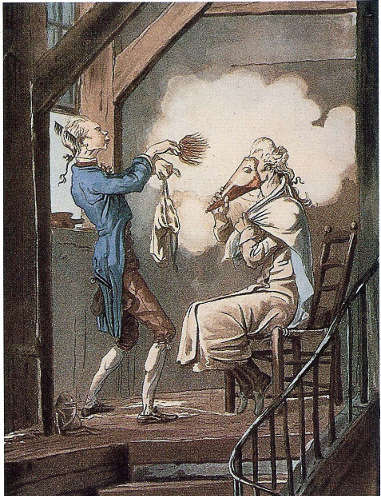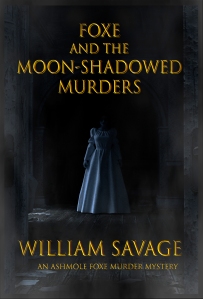
A gentleman’s servant applying wig powder.
I recently gave a talk to a local group on the subject of sea-bathing. In it, I mentioned the use of pomade or pomatum for the hair: a dressing originally including mashed, overripe apple, as the name suggests, along with a suitable grease (rendered suet or lard) and sometimes extra perfume.
My audience expressed horrified disbelief that anyone would cover their hair with lard (as children, we called it ‘dripping’, since it dripped from the roasting joint). Well, just to prove it, here is a genuine 18th-century recipe for pomade from “The Cookbook of Unknown Ladies”, a manuscript held by Westminster City Libraries. I have added a few words in square brackets to make it easier to read.
Pumeatum
Take one pound Hog’s Lard Rendired [rendered] 3 Ouncis [ounces] Mutton Suet 3 Ouncis Beef Marrow one Ounce of Virgins Wax[1] these must be melted in an earthen Pot [add] Alkanet Root [and] Strean [strain] throw [through] some Gauze Put one Drahm [drachm] Oyle of thime [thyme] holfe [half] an ounce of Burgamot [bergamot] one drahm oyle of Cloves.
Another 18th-century recipe I found was based on mutton fat with lily root (powdered dried orris root from Iris germanica, a very fragrant perfume), ‘benjamin’ and storax (these are both resins from plants). All these ingredients were heated, then mixed with almond paste and rose water.
All the animal fats had to be carefully washed, cleaned from blood or other impurities, cut into small pieces and then rendered (boiled down) to make a pure fat or lard. Since this was a troublesome process to do at home, an industry grew up to pre-prepare fats for pomades,. Some went further and produced and sold the pomades themselves. However, people obviously still preferred to make their own, else why the need for recipes? Perhaps the quality of the versions on sale was too variable or they were too expensive.
Other ingredients used in pomades included almond oil, coconut oil, spermaceti (an odourless, waxy substance found in the head cavities of the sperm whale) and, by the mid–19th century, mineral oils and vaseline. The French perfume industry seems to have been helped towards fame by the use of its powerful products to conceal the rancid smells of poorly-made pomades – or those past their sell-by dates!
Another occasional ingredient was Bear’s Grease. This seems to have been based on a belief in the Middle Ages that lard from bear fat rubbed on the head would cure baldness – probably because bears have shaggy fur[2]. Genuine Bear’s Grease was made from the fat of the brown bear mixed with beef marrow and a perfume (lavender, thyme, rose essence or oil of bitter almonds) to disguise the smell. However, bears were extinct in England by the 18th century and rather troublesome to hunt and kill elsewhere. As a result, many either heavily adulterated their limited supplies of bear’s fat with pig’s lard, or simply used the lard, dyed with a green colour to make it look darker and more exotic.
Problems
The animal grease and lard in pomades tended to attract all kinds of vermin and insects, so pomaded wigs easily became infested with mice or fleas. It’s even possible that the claim that someone’s hair looked like a rat’s nest was based on fact – at least to the extent that rats might creep up onto the pillows of sleeping ladies and nibble their hair!
Doctors often urged young ladies to use pomades sparingly at first, since cases were not uncommon where the hair became so matted and unpleasant that it fell out, or the head and shoulders displayed rashes caused by allergies to some of the ingredients.
Pomades must have been difficult to wash off, especially given the basic soaps available. However, it seems ladies’ hair was often brushed vigorously at night by their maids. This would probably have removed most of the dried fat and powder and may even have acted a little like a dry shampoo. However, the time it took to create the most elaborate hairstyles probably ensured they would be left in place for days or even weeks. Hence the presence of insects.
Use by Men
Gentlemen also used pomade on their wigs and both sexes often added ‘hair powder’ to produce a matte finish, since the grease in pomade would make your hair very glossy. Hair powder was most often made from sifted wheat flour, sometimes with the addition of a little powdered chalk or white clay. Indeed, the liberal use of such flour for hair powder in the middle of the 18th century in England was blamed for producing bread shortages! The powder was blown over the head with a kind of bellows, while the person protected their face, as shown in the illustration from 1768 at the head of this post.
Wigs and ladies’ hair-cushions would certainly collect fleas, lice and other vermin over time, but had the advantage that they could be taken away and boiled when the problem became too bad.
Pomades as hair dressing to make hair shiny or more manageable remained in use throughout the 19th century, right up to modern times. By then, vegetable oils were used or oil from whales. ‘Antimacassars’ were draped over the backs of chairs to protect the upholstery from Macassar oil. This was made with coconut or palm oil, combined with ylang-ylang oil from the flowers of the ylang-ylang tree and other fragrant oils.
However, there was little need to apply the new oils so generously, once the fashion for towering hairstyles for women and wigs for men died out. They were used more to make hair look shiny than to make it stand up. When ‘beehive’ hair returned in the 1960s, it was back-combed, not coated in grease. The fashion for truly spiky hair a few years later was dealt with by chemically-produced gels.
Bears, it seems, are more or less safe nowadays from being boiled down to produce grease for people’s heads!
- Clean beeswax. ↩
- It might also have been because the ingredient sounded suitably exotic and difficult to obtain. In the part of the world where I was born, old country people swore that gypsies – well-known for having rich, glossy, black hair – dressed it with badger’s grease or hedgehog grease. I don’t expect they did, but it sounded odd enough. When as a child I challenged the idea, I was asked, “Have you ever seen a bald gypsy?” Since I had seen very few genuine gypsies, if any, I had to admit I had not, so the case was deemed proved! ↩



I looked up alkanet root. It was used as a red dye.
LikeLike
Hi William: I am now an enthusiastic follower of your blog. Look for my review of The Killing Code on mine on February 29!
LikeLike
I shall watch out for it. Thank you so much!
LikeLike